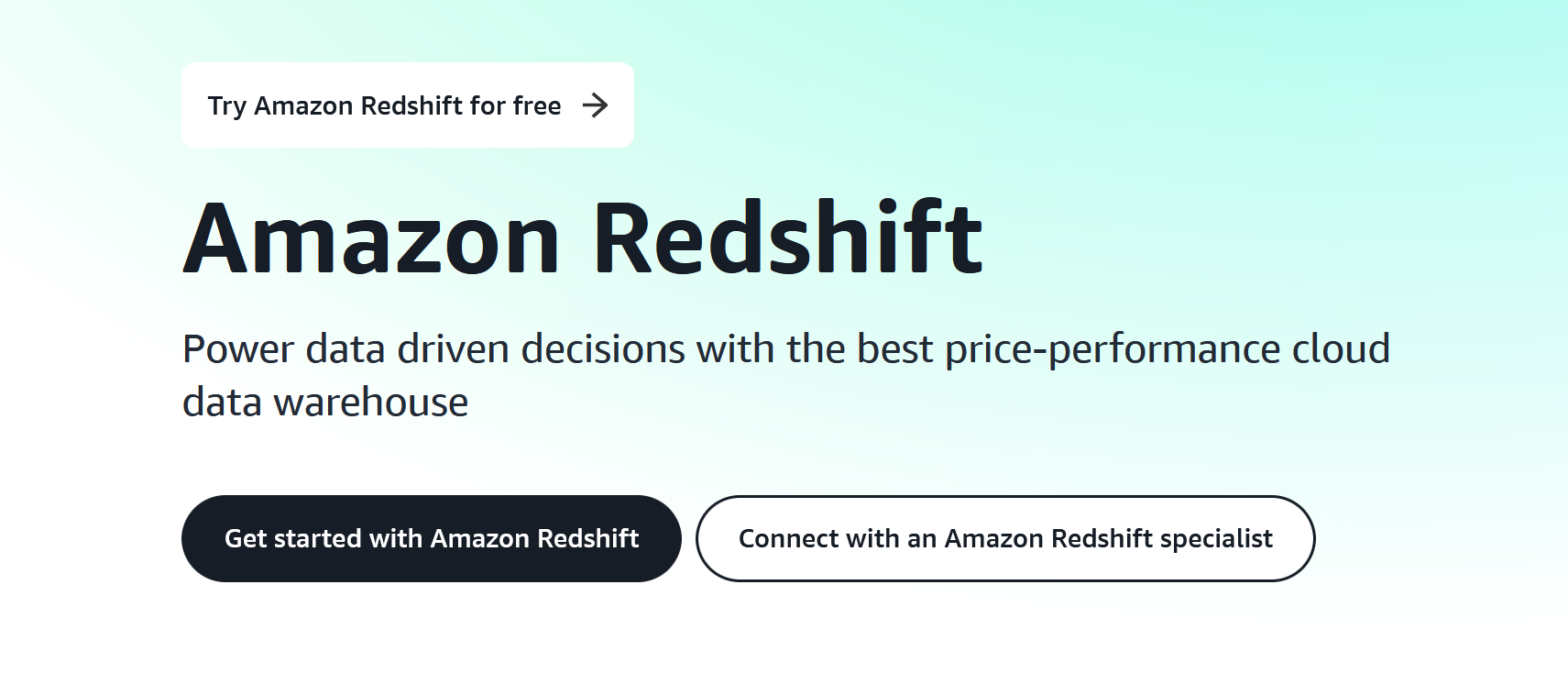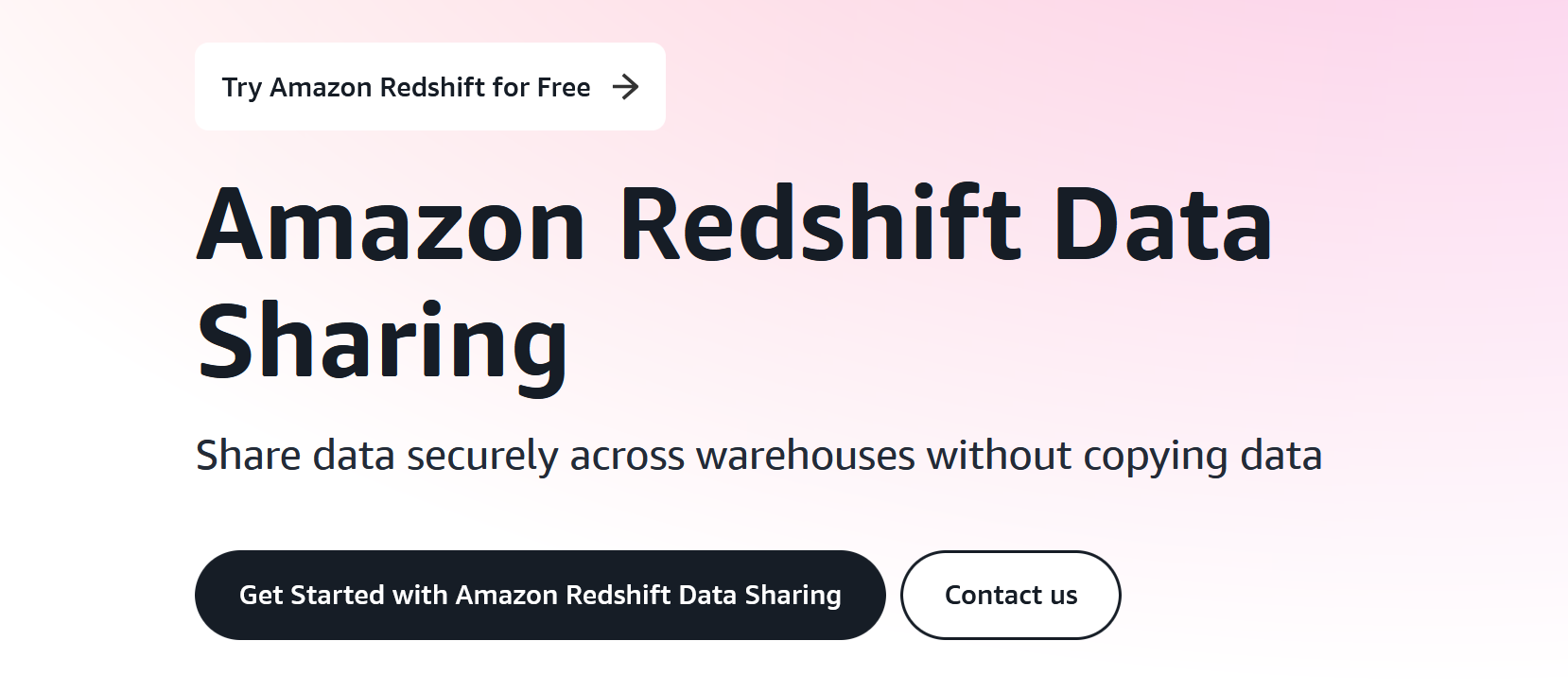The mass implementation of big data in various business sectors makes cloud platforms for data storage and analysis highly sought after. One of the services widely used in this area is Amazon Redshift. In this article, we will tell you about the tools and options it offers, what its operating principle is, and what its advantages and areas of application are.
What is Amazon Redshift?
Amazon Redshift is a scalable cloud data warehouse that is part of the Amazon Web Services suite of tools. It provides users with high-performance functionality for processing and analyzing data using standard SQL databases and business analytics. The platform allows you to query and combine both structured and semi-structured data at petabyte scale.
The operations can be performed using various resources, including storage, lakes, and operational databases. Storing query results in an S3 data lake using open Apache Parquet or Optimized Row Columnar (ORC) formats enables advanced analytics. Redshift is powered by massively parallel processing (MPP), is easy to run and configure, and provides various ways to import data.
Unlike another similar product, Amazon RDS, this platform is designed for serious analytical workloads for processing large datasets. The maximum volume of data it supports is up to 16 petabytes in one cluster. Amazon developed Redshift based on PostgreSQL 8.0.2, making significant changes to this DBMS. The beta version of the software appeared in 2012, and the full version was released in February 2013.

The platform supports integration with most external systems via ODBC and JDBC connectors. Parallel processing and compression allow it to simultaneously process billions of rows of data. Thanks to this, the system effectively performs operations on storing and analyzing big data from logs or live broadcasts. Below, we will tell you what features the platform offers and how high is Amazon Redshift costs.
Key Features and Pricing
So, what does Amazon Redshift do? In this section, you will learn about the main features of the cloud storage and the tariffs offered to its users.
The main capabilities of the platform:
- Columnar storage. The platform stores data in columns rather than rows, which reduces its volume and speeds up query execution. High compression ratios help reduce storage costs and optimize input/output processes.
- Data compression. The compression technologies used by Redshift allow you to significantly reduce the volume of data stored in the warehouse and increase the performance of their processing. The system automatically determines the optimal compression level, optimizing storage without user intervention.
- Massively parallel processing (MPP). The platform executes user queries in parallel across multiple compute nodes. This option helps distribute the workload evenly across all cluster nodes and speed up query processing. With MPP, Redshift efficiently processes complex queries against large datasets.
- Scalability. Storage clusters can be easily scaled by adding or removing nodes. Companies and organizations can easily adjust the number of resources they need to meet their current workload without losing performance.
- Data protection. Amazon Redshift provides a range of data protection features, including encryption at rest/in transit, access control through integration with AWS Identity and Access Management (IAM), encryption key management and rotation through AWS Key Management Service (KMS), and network isolation through Amazon VPC.
- Integration with the AWS ecosystem. Cloud storage is built into the AWS ecosystem of services, it supports integration with S3 (data storage), AWS Glue (cataloging), ETL and Amazon QuickSight (visualization and BI), AWS CloudTrail and AWS CloudWatch (logging, monitoring, alerts).
Amazon Redshift pricing is quite flexible and cost-effective, so it easily adapts to different business needs and workloads. Users can to choose the amount of computing resources and space they require. The platform allows you to use on-demand instances and pay for database usage by the hour without long-term contracts and upfront payments. Or select reserved instances for greater savings. Cloud storage services start at $0.25 per hour, and you are charged only for the capacity consumed during the workload.
How Does Amazon Redshift Work?
The platform provides a flexible combination of tools for cloud storage, management, processing, and analysis of huge data arrays.
Computing Nodes
The main structural element of the system is responsible for storing data and executing user queries. Redshift can add an unlimited number of nodes to its storage, depending on the volume of data uploaded by users. This allows you to quickly and efficiently scale resources, adapting them to the current load level. The leader node receives requests from client applications, analyzes SQL commands and distributes the code across all involved nodes for parallel processing. Then it collects the results and sends them to the client application. Each node in the system is equipped with its processor, memory and disk storage, which allows it to autonomously execute the segment of requests delegated to it.
Node Slices and Internal Network
All nodes in the Amazon Redshift architecture consist of slices, each of which contains a certain amount of memory and disk space. Slices work on tasks processed by the node in parallel, which increases the performance and scalability of processes. Another structural component of the platform is its internal high-bandwidth network. It ensures fast query execution and data transfer.
Relational Database
The relational database built into the platform is based on PostgreSQL, so it inherits the key features of this DBMS. With this component, Redshift easily and quickly processes complex queries to large-scale big data sets.
Parallelism and Integration with DynamoDB
By scaling parallelism, the system can handle multiple requests simultaneously without sacrificing performance. And thanks to integration with DynamoDB, it analyzes huge amounts of data in real time.
Serverless and Cloud Operations
Amazon Redshift serverless architecture frees the companies using it from worries about setting up and managing the technical infrastructure of the storage. The cloud solution guarantees maximum flexibility of the resources provided, allowing to quickly adjust their volume and capacity upon the client's request.
Integrations with AWS Services and Third-party Software
Redshift integration with the highly scalable Amazon S3 object storage service improves the performance of import/export operations, ensuring easy and fast data movement between the specified systems. Native connection with Redshift Spectrum allows you to analyze data at an exabyte scale. Integration with the IAM (Identity and Access Management) module provides secure and controlled access to stored information. Support for JDBC and ODBC connectors helps to connect the system easily with various external applications and tools.
Use Cases for Amazon Redshift

Next, we will answer another popular question — what is Amazon Redshift used for? This powerful tool is in high demand in the field of data storage and analysis. Its capabilities are actively used in the implementation of the following scenarios:
- Predictive analytics. Integration with Amazon SageMaker allows you to effectively use Redshift to develop ML models with predictive analytics features. Companies and organizations can generate personalized insights based on the data stored and processed by the platform.
- Business analytics. Cloud storage tools allow users to easily and quickly perform complex queries on large datasets. The wide potential for solving BI tasks ensures high demand for Redshift among businesses of different sizes and industries.
- Transition to Big Data. The platform’s scalability is a key benefit for customers looking to migrate their data from traditional systems to the cloud. Redshift’s resources are extremely useful for companies working with large volumes of data.
- Operational analytics. Another of the priority Amazon Redshift use cases is processing semi-structured data. For example, it can be used to automate the analysis of application logs, obtaining valuable information for their improvement.
- Data sharing: Redshift's integration with the Amazon ecosystem and third-party software makes it easier and faster to collaborate on data, while powerful security tools ensure reliable protection from unauthorized access.
Benefits and Advantages of Amazon Redshift
Cloud storage from Amazon is deservedly popular with companies and organizations from various industries. Users highly value the platform for its functionality, performance, and cost-effectiveness. Among the main advantages of Redshift are:
- Highly adaptable. The system scales automatically, adapting capacity and resource volume in real time to the current workload level. Dynamic adjustments help customers cope with peak loads without unnecessary cost increases or performance drops.
- Enhanced security. Amazon Redshift database has advanced data protection options, including access control, data encryption, virtual private cloud (VPC), and automated backups.
- Automation. The platform enables users to automate repetitive tasks without any technical skills or third-party tools. Automation of different types of processes is available: creating reports, auditing resources and costs, regular maintenance, etc.
- Easy deployment. Storage clusters are deployed and configured in minutes from anywhere in the world, making this solution very convenient for both individual and corporate users.
- Large ecosystem. Redshift supports native integrations with key AWS services and third-party products from Amazon's partner ecosystem.
Conclusion
Redshift Amazon is one of the most popular platforms for cloud storage and big data analytics today. Companies and organizations highly value this solution for its ability to process petabytes of data at high speed, its simple interface, and its cost-effectiveness. Part of Amazon Web Services, the tool is useful for solving many processes in different industries, including operational analysis, business analytics, and user behavior analysis. Support for massively parallel processing (MPP) significantly increases the system’s performance, and its virtually unlimited scalability makes it a universal solution for working with big data.
Also read on our blog:
- Comprehensive Review: Exploring the AI Capabilities of Databricks
- Perplexity AI: The AI-Powered Search Engine Revolutionizing Information Access
- Moveworks: Revolutionizing Workplace Productivity with Generative AI
- Mastering Cohere: A Guide to Advanced AI Language Models
- Understanding Kaggle: A Beginner's Guide to the Data Science Platform
